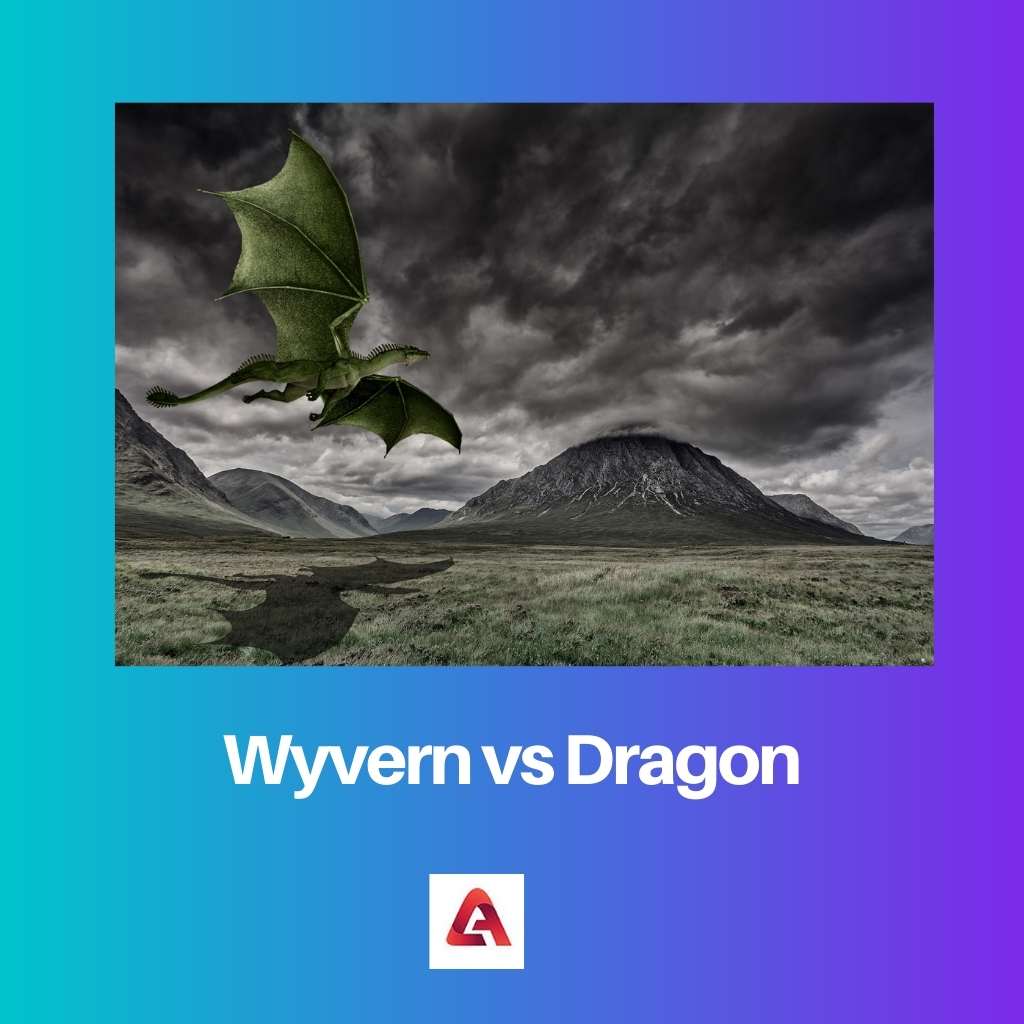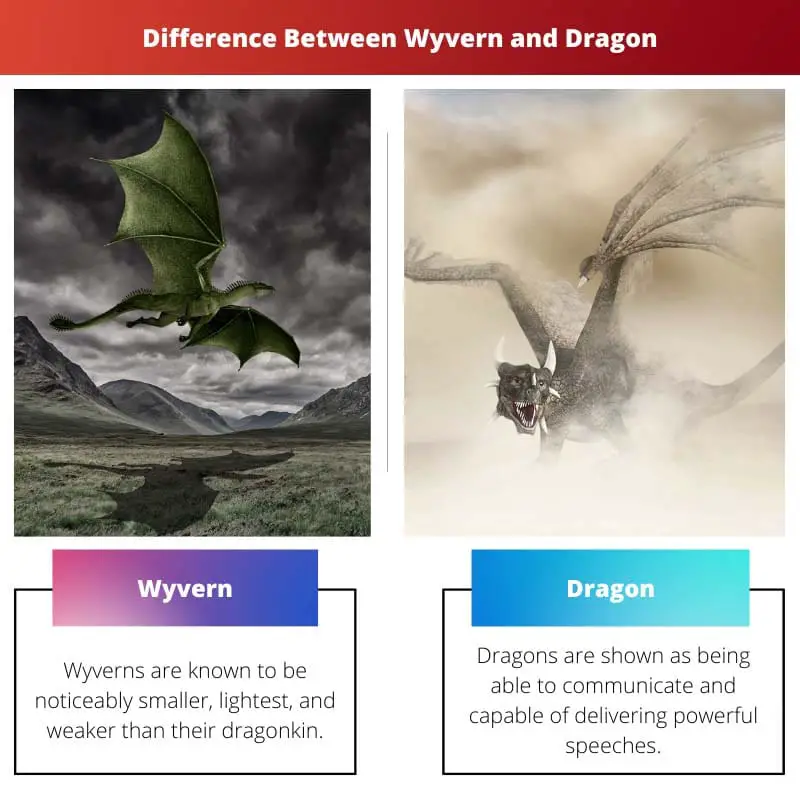Even though wyverns and dragons are both shown as flying monsters with feathers, wyverns are not as skilled flyers as dragons. Wyverns have beaked mouths, whilst dragons have enormous mouths with keen pangs.
Dragons come in various shapes, sizes, and colours, whereas wyverns have a consistent form. Unlike wyverns, dragons sometimes appear wingless and more reptile-like than wyverns.
Key Takeaways
- Wyverns are mythical creatures with two legs, wings, and a serpent-like tail, depicted with a venomous bite.
- Dragons are larger, more powerful mythical creatures, possessing four legs and the ability to breathe fire in many legends.
- Both wyverns and dragons are popular figures in literature, art, and folklore, but dragons tend to be more iconic and versatile in storytelling.
Wyvern vs Dragon
The difference between Wyvern and Dragon is that the Wyverns have two legs, while dragons have four. They didn’t shift their wings as quickly as dragons since their front legs are connected to their branches. Dragons are also far more significant than wyverns and are said to be the world’s most powerful creatures. It is impressive: dragons are tough to kill and can live for thousands of years if not destroyed.

A wyvern is a legendary creature that has its origins in Europe. It is sometimes related to the dragon subspecies, with which it shares many characteristics.
It is depicted as a vicious, dangerous, and dangerous creature with two legs and one set of wings, with some varieties having a fish-like tail, such as the sea wyvern.
However, more typical depictions show it with a barb on the tailor and a spade at the tip, both poisonous. In other images, it has eagle-like claws.
A dragon is one of the most well-known and easily recognized among mythical creatures. It is portrayed as a snake-like fire-spitting beast or a reptile with the capacity to fly.
Some dragons are depicted with legs, while others are without legs and with one or more heads. Their only known reproduction method is hatching, and they are supposed to be quite aggressive and assertive.
Diverse cultures have different interpretations of dragons; for example, in European culture, dragons are viewed as cruel and evil. In Chinese culture, dragons are associated with good fortune and power.
Comparison Table
| Parameters of Comparison | Wyvern | Dragon |
|---|---|---|
| Features | Wyverns stand on two legs. | Dragons stand on four legs |
| Description | Wyverns are known to be noticeably smaller, lightest, and weaker than their dragonkin. | Dragons are shown as being able to communicate and capable of delivering powerful speeches. |
| Creature | Wyverns are regarded as aggressive creatures with repulsive personalities. | Dragons are revered in some cultures as creatures of good fortune, particularly in Chinese legend. |
| Noise | They are silent. | They mostly make noise. |
| Harm | Wyvern isn’t harmful. | Dragon is very powerful and harmful. |
What is Wyvern?
The Wyvern, like the dragon, is depicted as a winged reptilian creature. It is recognized because it only has two legs and one pair of wings. A fish-like tail can be found on some variants, such as the sea wyvern.
The Wyvern’s tail is most commonly shown with a spike or a spade at the end, sometimes considered venomous. The claws of an eagle can also be depicted on the Wyvern. The lore surrounding wyverns is a bit inconsistent.
It is sometimes depicted as a smaller dragon species and others as a more giant dragon breed. Some reports say they are so enormous that they hunt rhinos and hippos.
Wyverns frequently appear in medieval heraldry, and many institutions continue to use them in their herald, emblems, and coats of arms. Wyverns are viewed as emblems of toughness, power, and perseverance.
Wyverns have also been seen in popular culture. In Neil Gaiman’s Sandman story, for example, a wyvern is the doorkeeper to Dream’s palace.
Wyverns appear in the mythologies of fantasy role-playing games such as Dungeon and Dragons and World of Warcraft.
Some cryptozoologists believe that wyverns are proof that species like theropod dinosaurs, winged reptiles that died out 65 million years ago, co-existed with human populations and may yet exist now.

What is Dragon?
Dragons are legendary beings. They infuse our stories with fire and soar through our minds. They are sometimes slaughtered by knights while guarding the gold heap.
People used to believe in dragons back in the day. They were even plotted on a map! The wretched dragons were held responsible for a slew of misfortunes.
Dragons were blamed for almost everything that couldn’t be explained, including disease, failed crops, terrible weather, and even war.
Dragons have appeared in most ancient cultures and traditions as mythical beings. They can be benign or evil and reside almost anywhere: in lakes, the sea, thunderclouds, and caves.
Dragons were known for their ability to breathe fire and their great might. One of the few monsters in mythology, the dragon is primarily described as a powerful and fearsome foe that needs to be defeated.
They don’t exist solely for their own sake; they primarily serve as a foil for daring adventurers.
Other mythological creatures, such as trolls, elves, and fairies, interact with humans (maliciously, sometimes usefully), but their primary function is not warfare.
Dragons are viewed as wicked in European culture and are frequently associated with the evil of Christian teaching.

Main Differences Between Wyvern and Dragon
- Wyverns walk on two legs, whereas Dragon walks on four legs.
- Wyverns are considered smaller, lighter, and weaker than their dragon counterparts. Dragons are found to be capable of communicating and giving compelling speeches. They’re also really smart creatures.
- Wyverns are less likely to communicate and prefer to remain silent mostly, whereas Dragons remain to make noise.
- Dragons are valued in some cultures as creatures of good fortune, particularly in Chinese tradition. Wyverns are violent creatures with terrible demeanours.
- The Wyvern isn’t dangerous. However, the Dragon is extremely powerful and dangerous.

- https://books.google.com/books?hl=en&lr=&id=xX0_EAAAQBAJ&oi=fnd&pg=PP1&dq=wyvern+and+dragon&ots=-tvgqdg653&sig=MSIzrihUxuaeTnCdg-kgWsHpRsQ
- https://www.britnumsoc.org/publications/Digital%20BNJ/pdfs/1985_BNJ_55_3.pdf